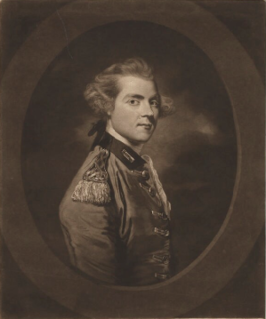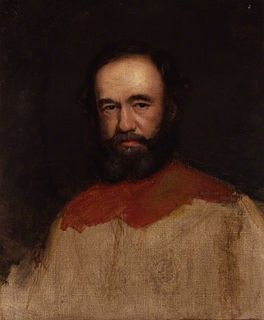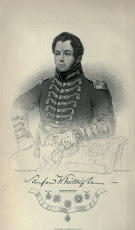 W
WLieutenant General John Archibald Ballard, CB LLD RE was a British soldier.
 W
WGeneral Sir John Cheape was a Scottish military officer of the Bengal Army in British India.
 W
WMajor-General Robert Clive, 1st Baron Clive, also known as Clive of India, was the first British Governor of the Bengal Presidency. He is credited along with Warren Hastings for laying the foundation of British rule in India. He began as a writer for the East India Company (EIC) who established the military and political supremacy of the EIC on the Indian subcontinent by winning the Battle of Plassey. In return for supporting the Nawab of Bengal Mir Jafar on the throne, Clive was granted a jaghire of £30,000 per year which was the rent the EIC would otherwise pay to the Nawab for their tax farming concession. When he left India he had a fortune of £180,000 which he remitted through the Dutch East India Company.
 W
WSir Barry Close, 1st Baronet was an army general in the East India Company and a political officer.
 W
WLieutenant-General Sir Eyre Coote, KB was a British soldier and politician who sat in the House of Commons from 1768 to 1780. He is best known for his many years of service with the British Army in India. His victory at the Battle of Wandiwash is considered a decisive turning point in the struggle for control in India between Britain and France. He was known by his sepoy troops as Coote Bahadur.
 W
WLieutenant General Sir Willoughby Cotton was a British soldier.
 W
WSir Robert Fletcher was an officer of the East India Company and a member of parliament for Cricklade. Fletcher joined the East India Company as a junior clerk in 1757 but soon transferred to its army. As a lieutenant he was cashiered (dismissed) for insolence but was later restored. Fletcher was awarded a knighthood for gallantry in battle and rose in rank to lieutenant-colonel in command of a brigade. He was court-martialled and cashiered for the second time by Robert Clive for involvement in the 1766 Monghyr Mutiny.
 W
WGeneral Sir Walter Raleigh Gilbert, 1st Baronet, was an army officer in the British East India Company.
 W
WGeneral Douglas Hamilton was a British Indian Army officer, gazetted to the 21st Regiment of the Madras Native Infantry from 1837 to 1871. He was a well known surveyor of the early British hill stations in South India and a famous sportsman, shikari, big-game hunter and trophy collector. He was an acute observer of nature and a gentleman. He legitimately shot more game in the Nilgiri Hills than any other sportsman.
 W
WMajor-General Thomas Hardwicke was an English soldier and naturalist who was in India from 1777 to 1823. He collected numerous specimens of natural history and had them painted by Indian artists. From these paintings many new species were described. Several of these species are named after him. On returning to England he collaborated with the zoologist John Edward Gray to publish Illustrations of Indian Zoology (1830–1835).
 W
WBrigadier-General John Jacob CB was an officer of the British East India Company who served in colonial India for the major portion of his career. He is known for the cavalry regiment called 36th Jacob's Horse, and for founding the town of Jacobabad, in modern day Pakistan, where he planned and supervised the transformation of thousands of acres of desert into arable land over the course of twenty years. The scale of progress and prosperity his works brought to the region can be appreciated by comparing those regions' relative prosperity compared to areas which were not under his administrative jurisdiction.
 W
WWilliam Kirkpatrick (1754–1812) was an East India Company officer, diplomat and orientalist active in Colonial India during the period of Company rule
 W
WMajor-General Stringer Lawrence was an English soldier, the first Commander-in-Chief, India
 W
WWilliam Nassau Lees (1825–1889) was a British Army officer in India, known as an orientalist.
 W
WGeneral Sir Robert Maclagan was a British Army officer and military engineer. He served most of his career in India.
 W
WGeneral Thomas R. MacQueen (1792–1840) was a British army officer in the 45th Bengal Native Infantry regiment of the British East India Company's Bengal Army.
 W
WMajor-general Sir John Malcolm GCB, KLS was a Scottish soldier, diplomat, East India Company administrator, statesman, and historian.
 W
WMajor-General Claude Martin was a French army officer who served in the French, and later British East India companies in colonial India. Martin rose to the rank of major-general in the British East India Company's Bengal Army. Martin was born in Lyon, France, into a humble background, and was a self-made man who left a substantial lasting legacy in the form of his writings, buildings and the educational institutions he founded posthumously. There are now ten schools named after him, two in Lucknow, two in Calcutta and six in Lyon. The small village of Martin Purwa in India was also named after him.
 W
WGeneral Sir Hector Munro, 8th laird of Novar KB was a British soldier who became the ninth Commander-in-Chief of India (1764–1765).
 W
WGeneral John Munro of the H.E.I.C.S was a Scottish soldier and administrator who served as Resident and Diwan of the States of Travancore and Cochin between 1810 and 1819.
 W
WMajor-General Sir Thomas Munro KCB was a Scottish soldier and colonial administrator. He served as an East India Company Army officer and statesman, in addition to also being the governor of Madras Presidency.
 W
WJames George Smith Neill was a Scottish military officer of the East India Company, who served during the Indian rebellion of 1857.
 W
WBrigadier General John Nicholson, was an Irish officer in the British Army who rose to prominence during his career in British India. Born in Ireland, Nicholson moved to the Indian subcontinent at a young age and obtained a commission in the East India Company where he spent the majority of his life helping to expand Company rule in numerous conflicts such as the First Anglo-Afghan War and the First and Second Anglo-Sikh War. Nicholson created a legend for himself as a political officer under Henry Lawrence in the frontier provinces of British India, especially in the Punjab, and he was instrumental in the establishment of the North-West Frontier. Nicholson's most defining moment in his military career was his crucial role in suppressing the Indian Rebellion of 1857, dying in the conflict.
 W
WLieutenant General Sir Jasper Nicolls KCB was Commander-in-Chief, India.
 W
WMajor-General Sir William Nott was a Welsh military officer of the Bengal Army in British India.
 W
WMajor-general Sir David Ochterlony, 1st Baronet of Pitforthy, 1st Baronet of Ochterlony GCB was a Massachusetts born military officer of the East India Company in British India. He held the powerful post of British Resident to the Mughal court at Delhi.
 W
WLieutenant-General Sir James Outram, 1st Baronet, GCB, KCSI was an English general who fought in the Indian Rebellion of 1857.
 W
WGeneral Sir Abraham Roberts was a British East India Company Army general who served nearly 50 years in India.
 W
WMajor-General James Stuart was a British Army officer who served in various conflicts in India during the 18th century. His service in the East India Company was marked by his conflict with Lord Pigot, the governor of Madras; Stuart's arrest of the latter in 1776 resulted in his suspension as commander-in-chief, and he was not vindicated until 1780. He later fought in the Second Anglo-Mysore War, but was suspended from command in 1782 by Lord Macartney, an action that provoked a duel between the two men. Stuart was a younger brother of the lawyer and politician Andrew Stuart.
 W
WGeneral Sir Robert John Hussey Vivian was a British officer in the Madras infantry from the Vivian family.
 W
WGeorge Warren was a British General who was a major figure in the Afghan and Indian wars of the early 19th century.
 W
WGeneral James Welsh was an English officer in the Madras Army of the East India Company.
 W
WSir Hugh Massy Wheeler KCB was an officer in the army of the East India Company. He commanded troops in the First Anglo-Afghan War, and the First and Second Anglo-Sikh Wars, and in 1856 was appointed commander of the garrison at Cawnpore. He is chiefly remembered for the disastrous end to a long and successful military career, when his defence of Wheeler's entrenchment and surrender to Nana Sahib during the Indian Rebellion of 1857 led to the annihilation of almost all the European, Eurasian and Christian Indian population of Cawnpore, himself and several members of his family included.
 W
WLieutenant General Sir Samuel Ford Whittingham, whose Christian names were contracted by himself and his friends into "Samford", was a British and Spanish army officer during the Napoleonic Wars. Following the conflict he served in the British Army predominately in India.